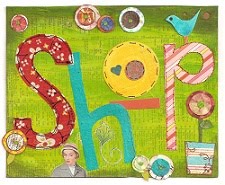Making what you need (and want) to make takes time. I mean it. Hours and hours and hours. And I can't just calculate the time it takes to make one project, either, since after I practice a little, I can often crank something out super fast. It's not just the making of a piece. It's the hours and hours it takes to develop the project. It's the time it took to learn the techniques that allow me to even get to the project development. It's my education and experience and time and skills all combined to make a single piece that I can show or sell or hang.
And then I'm asked to put a price on it that is in line with the current market, where things made abroad in assembly-line factories or by machines outprice me every time. Forgive me for voicing my discouragement (frustration? indignation?) on this matter. One realistic aspect of what it is to be an artist is to question: What is the value of my education, my trial and error, my acquired knowledge, my skills, and my time?
This semester, I'm taking a fibers class at the university. For one of our assignments (a "cover cloth") I made this:
- Hand sewing
- Machine sewing
- Dyeing
- Screen printing
- Color selection and matching
- Drawing
- Transferring a drawing to the screen printing process
- Quilting knowledge
- Computing
- Spacial sensibility
- Fabric selection based on type and texture
- Decisiveness
- Time management
While I was working hard late one night to finish it, I was on the phone with my mom saying that no one would ever notice this detail that I was putting into it. I was questioning whether it mattered that I include the detail at all. She responded that I had to do the detail for me, so that I could call the piece mine and be satisfied with the final outcome for myself. I considered this and carried on, even later into the night. (I did include the detail!)
It is the details that make the story of the piece. Have a look at this, my second-ever weaving done on a loom:
Here's a detail:
What are your thoughts, at first glance? What do you notice? What, if anything speaks to you?
Here is the story:
The assignment was to create a progression, one with a beginning and an end. Last month, I celebrated living in the house we live in for six years. It is a special thing for me. I've never lived in one abode for five years, let alone six.
My progression was to document of all the places I've lived. There are as many inches in the weaving as there are years of my life. Every section represents the places I've lived. Blue is Colorado, gray is Oregon, purple is Germany, etc. If you count up the colors and the different weaving designs within the colors, you'll see 18 different things, which relate to the 18 places I've lived. I had to leave out some places, the ones that lasted less than a year, to keep the momentum of the piece.
Here's the detail of the end, to show my 6 years of living in one house:
What are your thoughts, now that you've heard a little of the story? Has knowing the story and understanding the details made the value go up in your mind? Are you curious to know how long it took, not just to weave this, but to learn how to thread a loom, to learn the new vocabulary (and use it!) and design something for a loom that would come out the way I hoped it would?
A couple years ago I learned about the James Whistler case of 1877. An art purchaser thought Whistler's painting, Nocturne in Black and Gold: The Falling Rocket (1874), was overpriced for what it was, and said so publicly. Whistler took the man to court for libel. The court ruled in favor of Whistler. Here is an excerpt from the courtroom (Holker was the defendant's attorney; excerpt courtesy of Wikipedia):
Holker: "What is the subject
of Nocturne in Black and Gold: The Falling Rocket?"
Whistler: "It is a night piece and
represents the fireworks at Cremorne Gardens."
Holker: "Not a view of Cremorne?"
Whistler: "If it were A View
of Cremorne it would certainly bring about nothing but disappointment on
the part of the beholders. It is an artistic arrangement. That is why I call
it a nocturne...."
Holker: "Did it take you much time
to paint the Nocturne in Black and Gold? How soon did you knock it
off?"
Whistler: "Oh, I 'knock one off'
possibly in a couple of days – one day to do the work and another to finish
it..." [the painting measures 24 3/4 x 18 3/8 inches]
Holker: "The labour of two days is
that for which you ask 200 guineas?"
Whistler: "No, I ask it for the
knowledge I have gained in the work of a lifetime."
Here's Whistler's piece. And here's to the time and hard
work that goes into being a professional artist.













